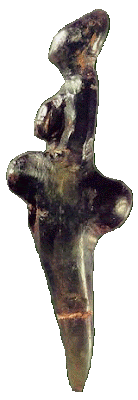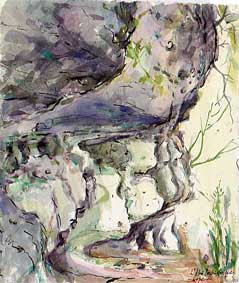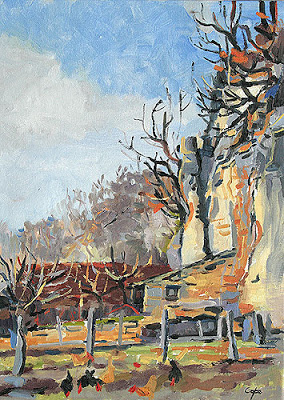
Oil on Canvas
8 paysage (46 x 33 cm ; 18,2 x 13 inches)
© The Artist.
sold
La Gravette, Dordogne

Green Steatite carving
discovered 1970
The above is the ‘Venus of Monpazier’ which is winy, small venus, found not far La Gravette. About 25 kilometres away (a day’s walk). In an open ploughed field. I talked to the man who discovered her. Apparently, he was just out walking. Upon finding her, he fell in love with ‘archeology’ & history. You can see a replica of her in L’Atelier des Bastides, Monpazier.
You can read more about her in Jean Clottes – Voyage en Préhistoire. Editeur: La Maison des Roches.
Other great achievements of this period was much body ornamentation & great ingenuity in making flint tools (I once found a solutrean spearhead lying on the ground, on the surface, right besides my foot, once whilst out painting. As it wasn’t from a acheological layer & had come to o the surface, it didn’t have much value as evidence).
What I like about many of the prehistoric sites in Périgord is that they are still inhabited to this day. 28 000 years of continued settlement. Some changes like the chickens picking away in the foreground & the pruning of the fruit trees (The Gravettian was pre-agriculture) , the odd bit of metal (stone age not metal age), a square window, some faced stone (though I bet they spread hides down from the cliff face in the same manner as this roof), but other than that, not much change. Sometimes, whilst painting quietly in these places, I imagine I can feel the continuity. Maybe there’s a need to reconnect with our sources in our modern, contemporary period, when there is much anxiety about man’s impact on the planet?

‘L’Abri Prehistorique 2″ 2001
Aquarelle.
40*30cm.
Copyright- the artist.
SOLD


